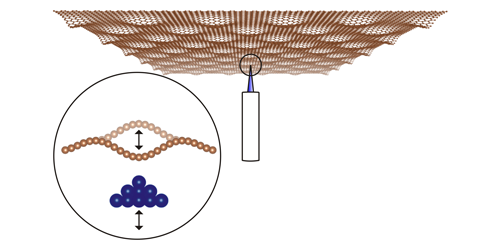Jiggling Graphene
Nearly 200 years after Robert Brown first documented the animated, wiggling motion of particles suspended in water, physicists are still uncovering secrets of Brownian motion. Paul Thibado from the University of Arkansas, Fayetteville, and colleagues have observed that freestanding graphene membranes quiver continuously up and down, much like Brown’s particles, but with intermittent interruptions when the jiggling causes the curvature of the membrane at small scales to flip. These room-temperature flips could be utilized to harvest energy to power nanomachines.
The team tracked the vertical motion of atom-sized regions of a suspended graphene membrane using a scanning tunneling microscope. The researchers adapted the device to image the motion nonstop for a period of 10,000 seconds. They found that the membrane wiggled in a random fashion, as expected for Brownian motion, with a maximum height change of 10 nm over the entire duration of the experiment. In addition, they observed that, from time to time, the membrane buckled—its curvature inverted—with high-speed, longer-length steps, or jumps, than the background wiggle. The kinetic energy of the jumps was large enough that, if converted into an electrical current, it might serve as a nanosized power source. While the researchers monitored the membranes for only two and three-quarter hours, they expect that this quivering, jumping motion would continue endlessly, allowing nanomachines to be powered continuously.
This research is published in Physical Review Letters.
–Katherine Wright
Katherine Wright is a Contributing Editor for Physics.





